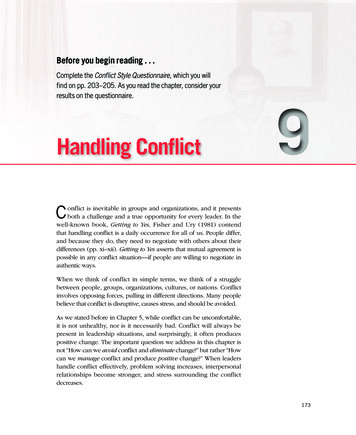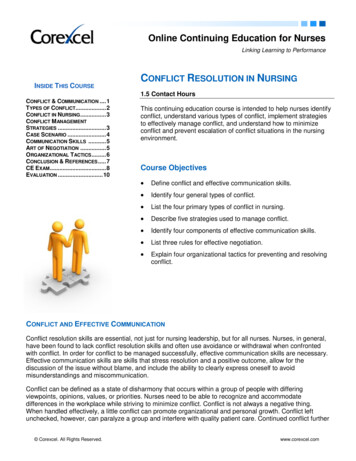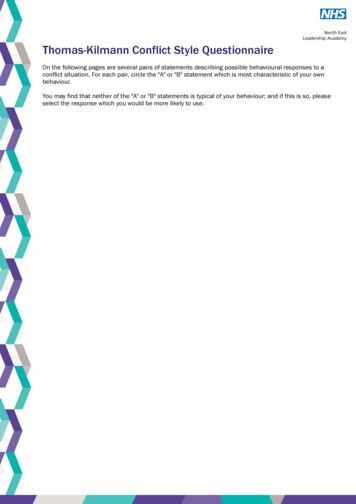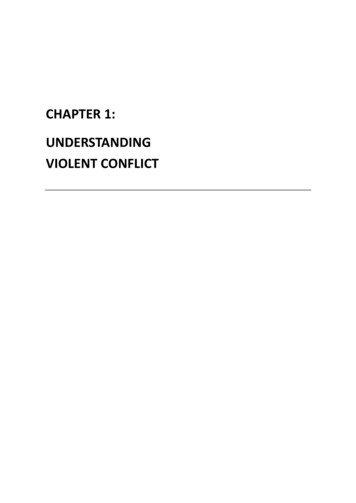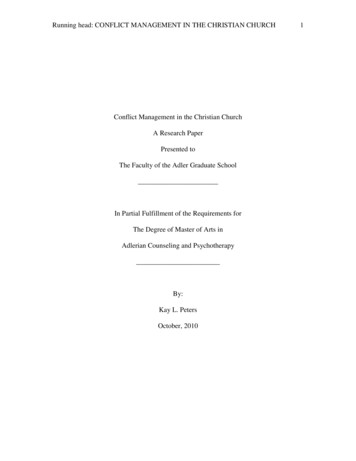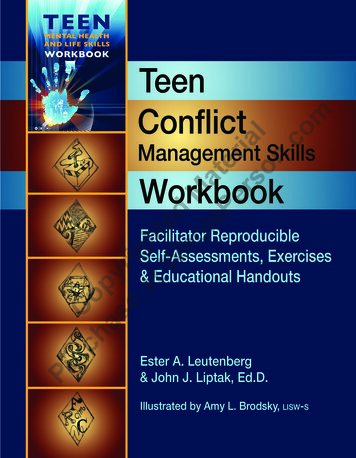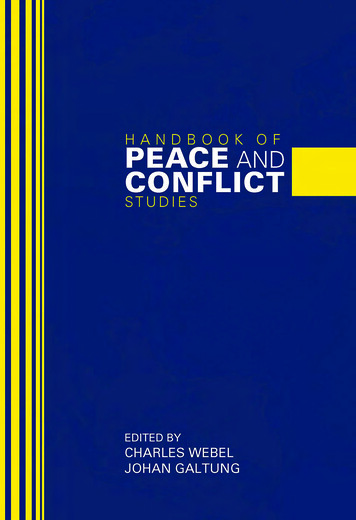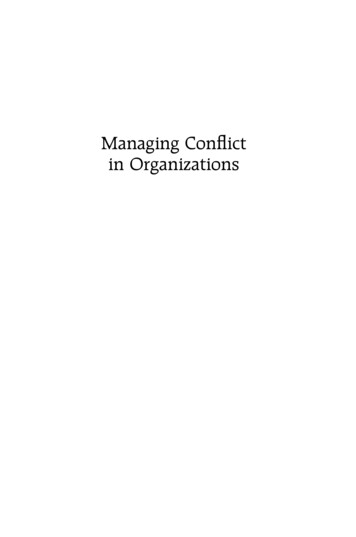
Transcription
Managing Conflictin Organizations
Managing Conflictin OrganizationsTHIRD EDITIONM. Afzalur RahimQUORUM BOOKSWestport, Connecticut London
Library of Congress Cataloging-in-Publication DataRahim, M. Afzalur.Managing conflict in organizations / M. Afzalur Rahim.—3rd ed.p. cm.Includes bibliographical references and index.ISBN 1–56720–262–4 (alk. paper)1. Conflict management. I. Title.HD42.R34 2001658.4'053—dc2100–037271British Library Cataloguing in Publication Data is available.Copyright 2001 by M. Afzalur RahimAll rights reserved. No portion of this book may bereproduced, by any process or technique, withoutthe express written consent of the publisher.Library of Congress Catalog Card Number: 00–037271ISBN: 1–56720–262–4First published in 2001Quorum Books, 88 Post Road West, Westport, CT 06881An imprint of Greenwood Publishing Group, Inc.www.quorumbooks.comPrinted in the United States of AmericaTMThe paper used in this book complies with thePermanent Paper Standard issued by the NationalInformation Standards Organization (Z39.48–1984).10 9 8 7 6 5 4 3 2 1
To Masuda and Sayeed
s from Various DisciplinesOrganizational ConflictSummary2714Nature of Conflict17Defining ConflictThreshold of ConflictConflict and CompetitionClassifying ConflictStyles of Handling Interpersonal Conflict1719192024Summary32Measurement of Conflict35Development of the ROCI–IDevelopment of the ROCI–IISummary364661Organizational Learning and Effectiveness63Defining Organizational LearningTypes of Learning6364
viii5.6.7.8.ContentsOrganizational EffectivenessCharacteristics of the Old Paradigm6568Conflict Management in the New ParadigmSummary7272Conflict Management Design75Defining Conflict ManagementContingency ApproachConflict Management Process758586Major Research ChallengesSummary9494Intrapersonal Conflict97Types of Intrapersonal Conflict97RoleRole Conflict9899Role AmbiguityA Model of Role Conflict and AmbiguityConsequences of Role ConflictManaging Intrapersonal ConflictSummary100101103104115Interpersonal Conflict117The Prisoner’s DilemmaA Model of ConflictConsequences of Interpersonal ConflictNegotiationManaging Interpersonal ConflictSummary117118122123125142Intragroup Conflict143Types of Groups144Effects of Intragroup ConflictManaging Intragroup Conflict145148Summary160
Contents9.10.11.ixIntergroup Conflict163Dynamics of Intergroup ConflictEffects of Intergroup Conflict164167Managing Intergroup ConflictIntervention168175Summary179Ethics and Morality181Ethics and Morality DefinedBehavioral Perspectives for Conflict ManagementEthical Evaluation of Conflict Management182183183Ethics and Leadership StructureFour Methods of Discourse184185Practical Methods and Conflict Management StylesStages of Moral 97A Design for Managing ConflictThe Ethics of Managing Conflict198206Appendix A: Cases1. Allen Manufacturing Corporation2. New Employee at the Credit Union3. Minnis Service4. The Hormel Strike at Austin, MinnesotaAppendix B: Exercises2092092112152182351.Contract Building2362.3.4.Technique of Role AnalysisJob DesignTransactional Analysis2372392405.6.Management of DisagreementsTeam Building2432447.Intergroup Problem Solving247
xContents8.9.Organizational MirroringAnalysis of Task Interdependence251253References257Author Index281Subject Index289
PrefaceDuring the last decade, business organizations in the United States came underintense competition from abroad. The implementation of the North AmericanFree Trade Agreement (NAFTA) and the General Agreement on Tariffs andTrade (GATT) is now intensifying competition on a global scale. As a result,numerous organizations are faced with the challenge of introducing innovativechanges to enhance their competitive position. The last decade has also seen bigchanges in the world with the collapse of socialism in Eastern Europe and theformer Soviet Union. The introduction of the market economies would requiremanagers in these countries to learn advanced management skills.Organizations are constantly changing in order to improve their competitiveposition, but this does not, of course, mean that our organizations are learningto manage conflict more effectively. The previous two editions of this bookmentioned that managers and administrators attempt not so much to understandand deal with conflict functionally as to find ways of reducing, avoiding, orterminating it. It appears that this state of affairs has remained unchanged. Asa result, valuable resources are wasted as employees engage in dysfunctionalconflict and miss the opportunity of utilizing functional conflict to improve theireffectiveness.In this edition, the major objective (i.e., to develop a design for the effectivemanagement of conflict at various levels in an organization) has remained unchanged. The thesis of this book continues to be that the management of organizational conflict involves the diagnosis of and intervention in conflict. Adiagnosis is needed to determine whether and to what extent an intervention isneeded to:1. Minimize affective conflict;2. Attain and maintain a moderate amount of substantive conflict; and
xiiPreface3. Enable the organizational members to learn and use the various styles of behavior,such as integrating, obliging, dominating, avoiding, and compromising, for handlingdifferent conflict situations effectively.One of the goals is to present the reader with additional scientific studies onconflict and conflict management that appeared in professional journals andbooks after the second edition of this work was published in 1992. Chapters 3(Measurement of Conflict), 4 (Organizational Learning and Effectiveness), and10 (Ethics and Morality) have been added to strengthen the macro conflict–management model.This edition can be used as a good supplement to courses on OrganizationalBehavior, Organizational and Industrial Psychology, Organizational Communication, and Organization Development. It will also be useful to the managementpractitioners and consultants on conflict management.I wish to express my special gratitude to Karen Jehn, University of Pennsylvania, Clement Psenicka, Youngstown State University, Jan Edward Garrett andNace Magner, Western Kentucky, and Robert Golembiewski, University ofGeorgia, for helping me to improve several parts of the book. I want to expressmy thanks to my management students of Youngstown State and Western Kentucky Universities, who provided the data for preparing the collegiate norms ofconflict and conflict styles. I want to express my appreciation to several anonymous reviewers for making comments on several parts of the book. Theiropinions were useful in refining some of my thoughts on conflict and conflictmanagement, but I am fully responsible for the final product.The price that an author’s family pays for a book is enormous. I express mygratitude and indebtedness to my wife and son for their patience and supportiveness. My wife was very supportive during various stages of the revision.Without her help it would have been very difficult to accomplish this task.
Managing Conflictin Organizations
Chapter 1IntroductionConflict is inevitable among humans. When two or more social entities (i.e.,individuals, groups, organizations, and nations) come in contact with one anotherin attaining their objectives, their relationships may become incompatible orinconsistent. Relationships among such entities may become inconsistent whentwo or more of them desire a similar resource that is in short supply; when theyhave partially exclusive behavioral preferences regarding their joint action; orwhen they have different attitudes, values, beliefs, and skills. “Conflict is theperception of differences of interests among people” (Thompson, 1998, p. 4).Another definition of conflict would bea process of social interaction involving a struggle over claims to resources, power andstatus, beliefs, and other preferences and desires. The aims of the parties in conflict mayextend from simply attempting to gain acceptance of a preference, or securing a resourceadvantage, to the extremes of injuring or eliminating opponents. (Bisno, 1988, pp. 13–14; see also Coser, 1968, p. 232)The theme of conflict has been with us and has influenced our thinking fromtime immemorial. It received different degrees of emphasis from social scientistsduring various periods of history. Over the years the phenomena relating toconflict havefallen within the purview of the historian, the novelist, the philosopher, and the theologian, and [have] been treated systematically by authors in all of the biological and socialsciences. Conflicts between nations, political parties, and ideologies have been examinedby the political scientist; conflicts in the market place have been examined by the economist; group conflicts of various kinds—familial, racial, religious, and social class—
2Managing Conflict in Organizationshave been investigated by the sociologist; and the struggle for survival by species ofdiffering genetic endowments has been studied by the biologist. (Nightingale, 1974,p. 141)Scholars in organization theory became interested in studying conflict only inrecent times. In recent years, there have been renewed interest and significantchanges in the study of conflict in social and organizational contexts. The formation of the International Association for Conflict Management and ConflictManagement Division of the Academy of Management to encourage research,teaching, and training and development on managing social and organizationalconflicts and the publication of the International Journal of Conflict Management attest to this renewed interest. In recent years, a number of universities inthe United States—Harvard, Northwestern, George Mason, for example—haveshown great interest in teaching and research on social and organizational conflicts.CONTRIBUTIONS FROM VARIOUS DISCIPLINESMost of the contributions to the theory of social conflict came from philosophy and sociology. A few contributions came from other disciplines, such asscience. A brief review of the major classical positions in these disciplines onthe concept of conflict would be helpful at this point.PhilosophyPlato and AristotleAlthough among the classical philosophers neither Plato (427–347 B.C.) norAristotle (384–322 B.C.) wrote a separate treatise on social conflict; both of themdiscussed in detail the need for order in a society.Plato was of the opinion that tension within society is natural, and thereforesome conflict is inevitable. “However, he felt that if a proper balance of theparts could be obtained, social conflict would be at a minimum. Each segmentof society must know the part it must play and be guided in such a fashion thatall segments work together in harmony” (Schellenberg, 1996, p. 89). Plato suggested that such a balance of the parts could be obtained only with appropriateleadership.In The Republic, Plato suggested that the needs of the society could be satisfied if private property was eliminated. To satisfy the needs of society, heparticularly felt the necessity for eliminating private property for those whowould provide political leadership. Plato believed that the leaders could not dotheir job properly if they were motivated by private interests.Aristotle, however, believed that Plato’s philosophy called for “extreme uni-
Introduction3fication” or communism and that this was neither practical nor possible. This isnot to say that Aristotle saw much usefulness of social conflict. On the contrary,although he disagreed with Plato on the form of the government, he sharedPlato’s sympathy for the need of order in the state. Plato and Aristotle stressedthat an absence of conflict is a sine qua non for the attainment of the just formof life in the city-state. To them, “strife is a sign of imperfection and unhappiness. Order marks the good life and disorders the opposite. Conflict is a threatto the success of the state and should be kept at an absolute minimum, andremoved altogether if possible” (Sipka, 1969, p. 7). The conclusion is that bothclassical philosophers assigned social conflict a pathological status.Thomas Hobbes and John LockeThe seventeenth-century social contract theories of Thomas Hobbes (1588–1679) and John Locke (1632–1704) suggested that the purpose of the government is to establish order in social relations, without which there would beconstant violence between human beings. Hobbes considered “human beings asegotistical, the dupes of error, the slaves of sin, of passion, and of fear. Personsare their own enemies, or the enemies of others, or both” (Lourenco & Glidewell, 1975, p. 489). He took the position that the Sovereign (i.e., a monarchwho is granted absolute and permanent power to control social conflict) shouldcontrol human beings. Whatever the Sovereign decides becomes the law, andall the citizens must abide by it. Since they have given him the right and powerto make them, they cannot object to his laws. This is the only way to controlsocial conflict effectively.Locke was critical of Hobbes’s disposition for the political order, the Leviathan, which is empowered with absolute control. According to Locke, government is to be organized by the people through their common consent and itsduty was the preservation of lives, liberties, and estates. Although Locke disagreed with Hobbes on the type of government he considered appropriate, heconcluded that government should control conflict.While there are some differences in their approaches to social theory, thosedifferences are at times not so great. BothHobbes and Locke had an extraordinary sensitivity to the dangers of social conflict andsought, through government, to control it as much as possible. . . . not only did thesemen not see a growth or re-constructive potential in social conflict, but they consideredit a flaw in the body politic. . . . Though neither man insists that all conflict is to beremoved, it is clear that this is their intention. (Sipka, 1969, pp. 15–16)G.W.F. Hegel and Karl MarxA distinct shift of views on conflict in philosophy occurred during the nineteenth century. It is not possible to review all of the major philosophical contributions that held to a functional view of conflict, but it would be useful to
4Managing Conflict in Organizationsreview the works of intellectual giants like G.W.F. Hegel (1770–1831) and KarlMarx (1818–1883).Hegel’s philosophy is dominated by the notion of the dialectic, which has,over the years, developed four different meanings: (1) arriving at the truth, (2)dialogue or debate, (3) process of ascertaining the unrestricted truth, and (4)process of change through the conflict of opposing forces (Reese, 1982). Hegel’sdialectic asserts that every finite concept (thesis, or the first doctrine) bearswithin itself its own opposite (antithesis, or the second doctrine). To overcomethe opposition, one must reconcile the opposing concepts by coming to a thirdposition (synthesis, or the third doctrine). The dialectical method thus effects asynthesis of opposites. The synthesis in turn becomes a new thesis, and thedialectical process continues until a fully developed synthesis (the AbsoluteIdea) is reached. Each stage in this process relates back to the previous idea butresults in broadened knowledge.The dialectics of Marx and Hegel are different. Marx saw human history asfull of conflict between classes—bourgeoisie (business class) and proletariat(working class)—which is the mechanism of change and development. Marxwas a revolutionary who wanted the capitalists to relinquish their power. Heand his associate Engel were quite candid about their opinion on revolution.They closed The Communist Manifesto with the following words: “The Communists . . . openly declare that their ends can be attained only by the forcibleoverthrow of all existing social conditions. Let the ruling classes tremble at aCommunist revolution. The proletariats have nothing to lose but their chains.Workingmen of all countries, unite!”The key to Marx’s dialectic, therefore, is associated with class conflict rootedin economic disparities. Marx believed that this class struggle (between havesand have-nots) would ultimately lead to a classless society devoid of repressionwhere human beings are, for the first time, truly free. This new society wouldbe free from conflict, and the individuals would be perfectly reconciled to themselves and their fellows.John DeweyAmong the philosophers who made significant contributions to the study ofsocial conflict during the twentieth century is John Dewey. He was profoundlyinfluenced by Darwin’s theory of evolution and Hegel’s dialectic process. ForDewey (1922/1957), “Conflict is the gadfly to thought. It stirs us to observationand memory. It instigates us to invention. It shocks us out to sheep-like passivity, and sets us at noting and contriving” (p. 300). He observed that when therelationship between human beings and environment is interrupted by obstaclesor conflict, individuals must use their intelligence to readapt through a changein their accustomed modes of conduct and belief. In other words, an individualshould examine a conflict situation to discover the various actions possible andchoose the one that is most effective.
Introduction5Biological ScienceCharles DarwinCharles Darwin (1809–1882), a naturalist, formulated the “theory of evolution,” which indicated that biological species survive and grow by confrontingenvironmental challenges. He indicated that “all nature is at war, one organismwith another, or with external nature. Seeing the contented face of nature, thismay at first be well doubted; but reflection will inevitably prove it is true”(quoted in Hyman, 1966, p. 29). This called for a reexamination of the classicalviews of the role of social conflict in human development. Darwin (1871) andhis followers (the social Darwinists) recognized the role that environmental conflict plays in human growth, which led to the development of the doctrine of“the survival of the fittest.” Darwin said:Man . . . has no doubt advanced to his present high condition through a struggle forexistence consequent on his rapid multiplication; and if he is to advance still higher, itis to be feared that he must remain subject to a severe struggle. Otherwise, he wouldsink into indolence, and the more gifted men would not be more successful in the battleof life than the less gifted (quoted in Sipka, 1969, p. 16)Darwin believed that the growth of human beings is a function of their response to conflict with the environment. If conflict were altogether absent—asappears to be the ideal in much of classical philosophy—the progress of humanbeings would be retarded. The evolutionary emphasis on the essential role ofconflict in human development is a pennant of the nineteenth century. ThroughDarwin, it found its way into virtually all facets of science.SociologyGeorg SimmelAmong the classical sociologists who made a significant contribution to thestudy of the various forms of conflict was Georg Simmel. His general hypothesiswas that a certain amount of conflict is as essential to the proper functioning ofgroups, as are stability and order. He believed that in small groups such as themarital couple, “a certain amount of discord, inner divergence and outer controversy, is organically tied up with very elements that ultimately hold the grouptogether; it cannot be separated from the unity of the sociological structure”(Simmel, 1908/1955, pp. 17–18).At the beginning of this century, there was considerable interest among theAmerican sociologists in the study of social conflict. They generally agreed withPark and Burgess (1921/1929): “Only where there is conflict is behavior conscious and self-conscious; only here are the conditions for rational conduct”(p. 578).
6Managing Conflict in OrganizationsElton MayoBeginning in the late 1930s, the study of social conflict began to be neglectedwith the publication of Elton Mayo’s (1933) and Talcott Parsons’s (1949) works.Mayo’s studies, which led to the human relations movement, emphasized theneed for cooperation for enhancing organizational effectiveness. To him, conflictwas an evil and should be minimized or, if possible, eliminated from organizations altogether. Child (1995) concluded that Mayo had adeep abhorrence of conflict in any form. . . . Mayo and his colleagues . . . assumed thatordinary employees were largely governed by a “logic of sentiment,” which was of adifferent order from managers’ rational appraisal of the situation in terms of costs andefficiency. Conflict with management was thus an aberration that threatened the effectiveness of organizations. (pp. 88–89)Talcott ParsonsTalcott Parsons’s (1949) formulation of the structural-functional theory considerably influenced social science thought following World War II. His theoryis based on the assumption that society is inherently stable, integrated, andfunctional, and, as a result, conflict is viewed to be abnormal and dysfunctional.“His model is through and through an equilibrium model and the dynamics ofconflict are relegated to the level of ‘deviation.’ All this stems, perhaps, fromParsons’s extraordinary, Hobbesian preoccupation with the natural tendency ofmen to hostility, and the difficulty of controlling them adequately” (Sipka, 1969,p. 70).Lewis CoserDuring the 1950s a number of theorists (Mills, 1959; Dahrendorf, 1959; Bernard, 1957; Coser, 1956) presented viewpoints opposing Parsons’s analysis.Consequently, the interest in the study of the social phenomena of conflict beganto grow. The publication of The Functions of Social Conflict by Lewis Coser(1956), which focused on the productive potential of conflict, had much to dowith this renewal of interest. Coser (1956) interpreted and expanded Simmel’sessay in considerable detail. Hereminded his fellow social scientists of the key role that conflict always plays for society.His book was highly influential in reminding sociologists of ideas that had been centralearlier in the century (in writings such as those of Park and Burgess and of Simmel),thus setting the stage for a remarkable rise in sociological attention to conflict in theperiod since then. (Schellenberg, 1996, p. 66)Two opposing viewpoints on the outcome of conflict were presented. A synthesis of these viewpoints regarding the usefulness of conflict is necessary. Arealistic view of conflict is that it has productive as well as destructive potentials(Assael, 1969; Deutsch, 1969; Jehn, 1997a; de Dreu & van de Vliert, 1997;
Introduction7Kelly & Kelly, 1998; Pelled, Eisenhardt, & Xin, 1999). The functional anddysfunctional outcomes of conflict in organizations are as follows:Functional Outcomes Conflict may stimulate innovation, creativity, and growth. Organizational decision making may be improved. Alternative solutions to a problem may be found. Conflict may lead to synergistic solutions to common problems. Individual and group performance may be enhanced. Individuals and groups may be forced to search for new approaches. Individuals and groups may be required to articulate and clarify their positions.Dysfunctional Outcomes Conflict may cause job stress, burnout, and dissatisfaction. Communication between individuals and groups may be reduced. A climate of distrust and suspicion can be developed. Relationships may be damaged. Job performance may be reduced. Resistance to change can increase. Organizational commitment and loyalty may be affected.The preceding discussion suggests that social conflict has both positive andnegative consequences. If a social system is to benefit from conflict, the negativeeffects of conflict must be reduced and positive effects must be enhanced.ORGANIZATIONAL CONFLICTHaving recognized that conflict is an important social concept, we can thenlook into the special case of organizational conflict. Conflict is certainly one ofthe major organizational phenomena. Pondy (1967) observed that organizationtheories “that do not admit conflict provide poor guidance in dealing with problems of organizational efficiency, stability, governance, and change, for conflictwithin and between organizations is intimately related as either symptom, cause,or effect, to each of these problems” (p. 504). It has been observed by Baron(1990) that “organizational conflict is an important topic for both managers andfor scientists interested in understanding the nature of organizational behaviorand organizational processes” (p. 198). Content analysis of syllabi on organizational behavior courses for master of business administration (MBA) studentsby Rahim (1981) indicated that conflict was the fifth most frequently mentionedamong 65 topics.
8Managing Conflict in OrganizationsThe Classical View of Organizational ConflictThe classical organization theorists (Fayol, 1916/1949; Gulick & Urwick,1937; Taylor, 1911; Weber, 1929/1947) did not seem to appreciate differentimpacts that conflict can have on organizations. They implicitly assumed thatconflict was detrimental to organizational efficiency and therefore should beminimized in organizations. They prescribed organization structures—rules andprocedures, hierarchy, channel of command, and so on—so that organizationmembers would be unlikely to engage in conflict. This approach to managingorganizations was based on the assumption that harmony, cooperation, and theabsence of conflict were appropriate for achieving organizational effectiveness.Frederick TaylorFrederick Taylor (1911) and his associates believed that the functioning ofan organization would improve if the principles of scientific management wereimplemented. Some of these principles involved the following:1. The development of a true science of work that involves determining a fair day’swork.2. Scientific selection and progressive development of workers.3. Fitting of workers to their respective tasks.4. Constant and intimate cooperation of managers and workers.5. Provision of means to encourage each person to the utmost utilization of his or hercapacity.6. Development of organization structures to control the various phases of production.Taylor particularly insisted that the conflicts between labor and managementwould disappear if these principles were applied. Although scientific management led to significant advancement in industrial efficiency, it was not withoutopposition. During the later part of his life, Taylor was subjected to much criticism by labor. The opposition from organized labor was due to their belief thatscientific management resulted in speedup of the workers. The unions also objected to the scientific determination of wages without resorting to collectivebargaining. Scientific management also did not make any provision for the effective management of conflict between individuals and groups in an organization.Henry FayolAnother classical organization theorist was Henry Fayol, a French executive.Today’s organization theory is greatly indebted to Fayol (1916/1949). In somerespects his work was superior to that of Taylor. Fayol advocated that the managerial functions, such as planning, organizing, command, coordination, andcontrol, are applicable to all sorts of organized human endeavor. In addition to
Introduction9this, some of his organization principles, such as unity of command, span ofcontrol, division of work, and so on, are widely used today. Although Fayol’sapproaches to management were broader and more systematic than those ofTaylor, both of them, as well as other classicists such as Gulick and Urwick(1937) and Mooney and Reiley (1939), saw organizations from a closed-systemperspective. They implicitly assumed that conflict was detrimental to organizational effectiveness. They prescribed mechanistic organizational structures withclear lines of authority, hierarchical structures, division of labor, and so on,which would encourage harmony and cooperation and suppress or eliminateconflict among members.Max WeberMax Weber (1929/1947), a distinguished German sociologist, proposed astructure of organization that he called bureaucracy and believed it to be themost efficient form of organization. Bureaucratic organizations must follow several fundamental principles:1. A well-defined hierarchy of authority.2. Division of work based on functional specialization.3. A system of rules covering the rights and duties of employees.4. A system of procedures for dealing with work situations.5. Impersonality in interpersonal relationships.6. Selection of employees and their promotion based on technical competence.Weber left no room for conflict or deviance in his model of bureaucracy.Although he was aware of some of the dysfunctions of bureaucracy, he maintained that bureaucratic structures were appropriate for organizational effectiveness.Mary Parker FollettAmong the classical organization theorists, Mary Parker Follett (1926/1940)was a significant exception. Her strong behavioral orientation to managementand organization in the 1920s placed her several decades ahead of her time. Shenoted the value of constructive conflict in an organization: “We can often measure our progress by watching the nature of our conflicts. Social progress is inthis respect like individual progress; we become spiritually more and more developed as our conflicts rise to higher levels” (Follett, 1926/1940, p. 35). Shestrongly advocated the need for an integrative (problem-solving) method formanaging organizational conflict. She believed that other methods of handlingconflict, such as suppression, avoidance, dominance, and compromise, were ineffective in dealing with conflict.
10Managing Conflict in OrganizationsThe Neo-Classical View of Organizational ConflictAs discussed before, the studies of Elton Mayo (1933) during the 1920s and1930s, which led to the human relations movement, a
A Design for Managing Conflict 198 The Ethics of Managing Conflict 206 Appendix A: Cases 209 1. Allen Manufacturing Corporation 209 2. New Employee at the Credit Union 211 3. Minnis Service 215 4. The Hormel Strike at Austin, Minnesota 218 Appendix B: Exercises 235 1. Contract Building 236 2. Technique o

